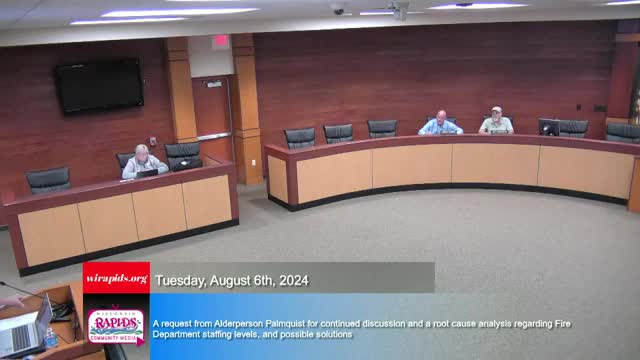Fire Department Faces Staffing Crisis Amid Rising Call Volumes
August 07, 2024 | Wisconsin Rapids, Wood County, Wisconsin
This article was created by AI summarizing key points discussed. AI makes mistakes, so for full details and context, please refer to the video of the full meeting. Please report any errors so we can fix them. Report an error »

During a recent government meeting, officials discussed critical staffing challenges facing the local fire department, highlighting the need for additional personnel to meet increasing call volumes. The conversation centered around the implications of the National Fire Protection Association (NFPA) standards, which recommend a minimum of 16 firefighters for optimal safety and response capabilities. Currently, the department is operating with 15 firefighters, following the addition of three new staff members in 2022.
Concerns were raised regarding the calculation of staffing levels, particularly how the department's ratio of firefighters to residents decreased despite the increase in personnel. Officials noted that historical staffing decisions were influenced by overtime costs and the need to adapt to rising demands. The discussion also touched on the importance of long-term planning, with projections indicating that the department may face similar staffing pressures in the coming years as the population ages and healthcare needs rise.
One official suggested the possibility of engaging a third-party consultant to provide an external perspective on the department's staffing needs, similar to a previous review conducted for the police department. This approach aims to identify effective solutions and ensure that the department can sustainably manage its resources moving forward.
The fire chief emphasized that the current staffing plan is designed to alleviate immediate pressures while preparing for future demands. He noted that the aging population, particularly the baby boomer demographic, significantly impacts call volumes, and as this group transitions out, the department may see fluctuations in service needs. However, he cautioned that another wave of demand could arise from a younger population entering the healthcare system in the coming decades.
As discussions continue, officials are committed to exploring all options to enhance the fire department's capacity and ensure community safety. Further meetings are anticipated to refine strategies and consider the potential for external assessments to guide decision-making.
Concerns were raised regarding the calculation of staffing levels, particularly how the department's ratio of firefighters to residents decreased despite the increase in personnel. Officials noted that historical staffing decisions were influenced by overtime costs and the need to adapt to rising demands. The discussion also touched on the importance of long-term planning, with projections indicating that the department may face similar staffing pressures in the coming years as the population ages and healthcare needs rise.
One official suggested the possibility of engaging a third-party consultant to provide an external perspective on the department's staffing needs, similar to a previous review conducted for the police department. This approach aims to identify effective solutions and ensure that the department can sustainably manage its resources moving forward.
The fire chief emphasized that the current staffing plan is designed to alleviate immediate pressures while preparing for future demands. He noted that the aging population, particularly the baby boomer demographic, significantly impacts call volumes, and as this group transitions out, the department may see fluctuations in service needs. However, he cautioned that another wave of demand could arise from a younger population entering the healthcare system in the coming decades.
As discussions continue, officials are committed to exploring all options to enhance the fire department's capacity and ensure community safety. Further meetings are anticipated to refine strategies and consider the potential for external assessments to guide decision-making.
View full meeting
This article is based on a recent meeting—watch the full video and explore the complete transcript for deeper insights into the discussion.
View full meeting
